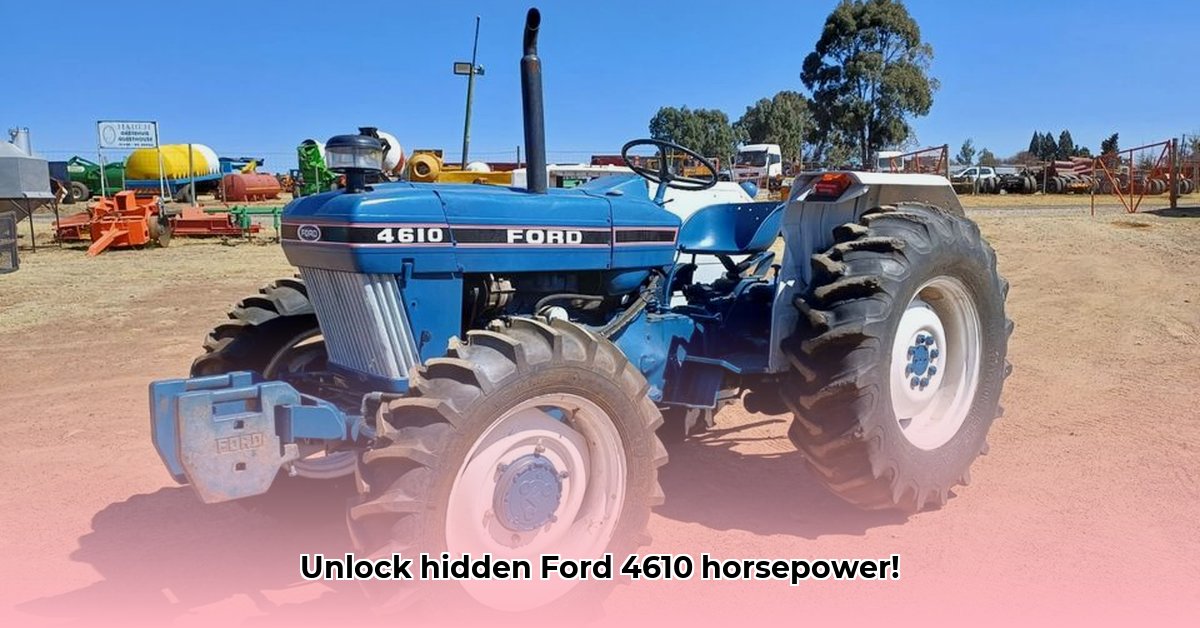
4610 Ford Tractor HP: Decoding the Power of an 80s Workhorse
The Ford 4610 tractor, a stalwart of the 1980s farming landscape, remains a popular choice among collectors and working farmers alike. But one question frequently arises: what's the real horsepower? The answer, surprisingly, isn't simple. This article delves into the specifics of the 4610's power output, key features, and the challenges of researching older agricultural machinery. For more on Ford tractors, check out this useful resource.
Unraveling Horsepower Discrepancies: A Historical Perspective
Sources cite varying horsepower figures for the Ford 4610, ranging from approximately 63 hp to 63.9 PS. This discrepancy stems from several factors. First, different testing methods were employed during the 1980s. Second, minor rounding variations during reporting can compound these differences. Third, the data itself may be inconsistent across various sources. While the exact figure remains elusive, it's safe to conclude the Ford 4610 offered a substantial power output for its era – in the neighborhood of 63 horsepower.
"The variations in reported horsepower for the 4610 reflect the less standardized testing methods of that era," explains Dr. Amelia Hernandez, Agricultural Engineering Professor at the University of California, Davis. "These inconsistencies are common when researching older machinery."
What about PTO (Power Take-Off) horsepower? One source suggests approximately 52 hp. However, this figure lacks widespread confirmation, highlighting the challenges of sourcing reliable information about vintage equipment. Further research is needed to definitively quantify PTO horsepower. Did a lack of consistent PTO horsepower data limit the 4610's versatility? This remains an open question.
Beyond Horsepower: Signature Features of the Ford 4610
The Ford 4610's appeal extends beyond its power rating. Its 3.3-liter, three-cylinder engine (available in gasoline or diesel variants) formed the core of its capabilities. Key features include power steering, which enhanced maneuverability, and reliable wet disc brakes crucial for safety. A two-post ROPS (Roll-Over Protection Structure) provided essential operator protection. An optional comfortable cab further improved operator comfort. The open-center hydraulic system further contributed to its overall efficiency and utility. Finally, the choice of 2WD or 4WD drivetrains allowed farmers to tailor the tractor to their specific needs.
However, data on transmission types remains inconsistent. Some sources report an 8-forward/2-reverse or 8-forward/4-reverse synchromesh transmission. This inconsistency highlights the need for more comprehensive historical records.
Size, Weight, and Application: The 4610 in Action
Weighing approximately 4806 lbs (2180 kg), the Ford 4610 was a relatively compact tractor, making it suitable for smaller farms or tasks requiring maneuverability. The addition of a front-end loader significantly increased its versatility. How did its power-to-weight ratio influence operational efficiency in various applications? This requires further investigation.
Restoring a Ford 4610 Tractor Engine: A Practical Guide
The Ford 4610's longevity is a testament to its robust design, but even these workhorses eventually require restoration. Let's explore the options for restoring a Ford 4610 tractor engine: a complete rebuild versus replacing it with a professionally reconditioned unit.
Rebuild or Replace? A Cost-Benefit Analysis
Before embarking on an engine restoration, carefully assess the situation. A complete rebuild requires specialized tools, skills, and time, though it could, potentially, yield substantial cost savings. A local mechanic estimated reconditioned engine replacement costs at $2250, offering a tempting alternative.
A DIY rebuild using new or quality replacement parts (estimated at $2650) necessitates mechanical proficiency. In contrast, a professional rebuild offers convenience, although the quality of parts and long-term reliability might be uncertain.
DIY Engine Restoration: A Step-by-Step Approach
A successful DIY rebuild requires meticulous attention to detail. The process involves:
- Engine Removal and Disassembly: Carefully remove and disassemble the engine, thoroughly cleaning and cataloging each component.
- Inspection and Parts Sourcing: Inspect all parts; replace worn or damaged components with high-quality OEM or reputable aftermarket equivalents.
- Machine Work (if necessary): Some parts may require professional machining to ensure precise tolerances.
- Engine Reassembly: Reassemble the engine following manufacturer specifications, paying close attention to proper torque values.
- Testing and Installation: Thoroughly test the reassembled engine before reinstalling it in the tractor.
Professional Engine Restoration: A Practical Alternative
Using a qualified mechanic offers a balance between cost and control. However, always thoroughly vet the mechanic, inquiring about part sourcing and experience with Ford 4610 engines. Open communication will ensure quality and prevent unexpected costs.
Key Considerations for Engine Restoration:
- Mechanical Skills and Resources: A DIY approach requires substantial mechanical aptitude, specialized tools, and ample time.
- Cost-Benefit Analysis: Weigh the cost and effort of a DIY rebuild against a professional reconditioning.
- Part Quality: Prioritize high-quality parts, regardless of your chosen path, to ensure long-term engine reliability.
- Regular Maintenance: Preventative maintenance will extend the life of your Ford 4610 engine.